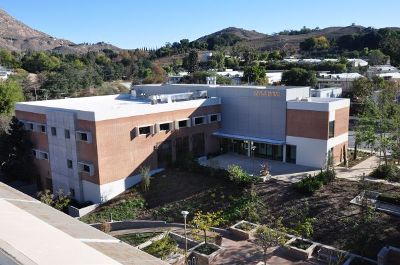Feb 6 2014
Most people look at a building and see windows and doors; John Cook, UC Riverside’s Director of Sustainability, sees a chance to change the world, one structure at a time.
 UCR's School of Medicine Education Building Credit: Ross French
UCR's School of Medicine Education Building Credit: Ross French
His latest “conquest” is UC Riverside’s newly remodeled School of Medicine Education Building, the second building on campus to meet the new University of California policy requiring that all new construction and major renovations earn a LEED Silver certification and exceed California’s Title 24 building code for energy efficiency by at least 20 percent.
LEED (Leadership in Energy and Environmental Design) is a nationally recognized benchmark for cost-efficient and energy-saving green buildings, overseen by the non-profit U.S. Green Building Council. And when they say “green,” they mean much more than installing insulation and energy-efficient windows.
A LEED certification basically dissects a building and its landscaping to find as many ways as possible to improve its energy use and environmental health, such as:
- Checking the building “envelope” to ensure there are no gaps around doors and windows to the outside.
- Installing light-colored “cool roofs” to reflect heat away from the building.
- Replacing high-wattage incandescent lighting with low-wattage, more energy-efficient fluorescent lights.
- Adding drought-resistance landscaping that doesn’t require energy-guzzling maintenance (like regular mowing), but still provides green spaces that keep the surrounding area cooler and more pleasant than expanses of concrete.
- Ensuring the building uses non-toxic paints, adhesives and cleaning supplies, and mixing them on site to cut down the energy required to move large volumes of liquid around.
- Using recycled materials for construction and recycling as much of the building waste as possible. UCR recycled 95 percent of the concrete, metal and other waste from the School of Medicine Education Building remodel, and is recycling 99 percent of the waste from its two biggest construction projects—the Glen Mor 2 student housing and the new Student Recreation building.
That scale of recycling requires some serious planning, and it is slightly more expensive, Cook said, “but the costs were insignificant compared to the savings from not filling up our landfills and producing gases with global warming potential. We’re a state university; we want to serve the state and the world, but we also want to set an example and be a good citizen. The costs have gotten down to where they’re definitely affordable, and we’re certain that what’s going to recyclers is actually being recycled, so partly, we’re doing this just to show it can be done.”
UCR actively began seeking LEED certifications in 2012, and earned its first award—a LEED Gold certificate—for the new School of Medicine Research Building last year. It hopes to earn two more gold certificates for new construction this year with the 800-bed Glen Mor 2 dormitory and the Student Recreation Center, and a gold certificate for operation and maintenance in existing buildings at Glen Mor 1.
“President Janet Napolitano has made the commitment that all University of California campuses will have a net-zero carbon footprint by 2025,” Cook said, “which means all greenhouse gases from associated energy use on campus either be zero, or we offset that energy use by changing our behaviors to conserve or make our use more efficient.”
Installing an 11-acre solar farm later this summer will help UCR achieve its net zero goal, by producing an anticipated 6.6 million kilowatt hours of solar energy per year, all of which will be used on campus, and over 20 years, reduce its overall electricity costs. But Cook said it’s important to include all the ways sustainability can help when you are looking at the potential savings of going green.
For instance, he said, how many people get lung cancer or other serious diseases from air pollution; how much does it cost to clean up oil seepage at superfund sites, and what are the losses from drought? “There’s also the social impact,” Cook said. “Where does pollution have its biggest impacts? In the less economically-developed communities. And who is going to suffer when the grid goes down? Lower income people.”
Cook sometimes gets resistance to green practices, “but that’s OK,” he said. “That’s one of the reasons we have a policy; even if someone’s not comfortable with it, they still have to abide by it, until we can help them see the full value of sustainability. These policies are well thought out. The science is there, and what we need to remember is the people who are making these claims about climate change and what the solutions might be are the exact people the University of California educates and employs. Sustainability is not at all separate from the core mission of the university.”